Health Begins At Home
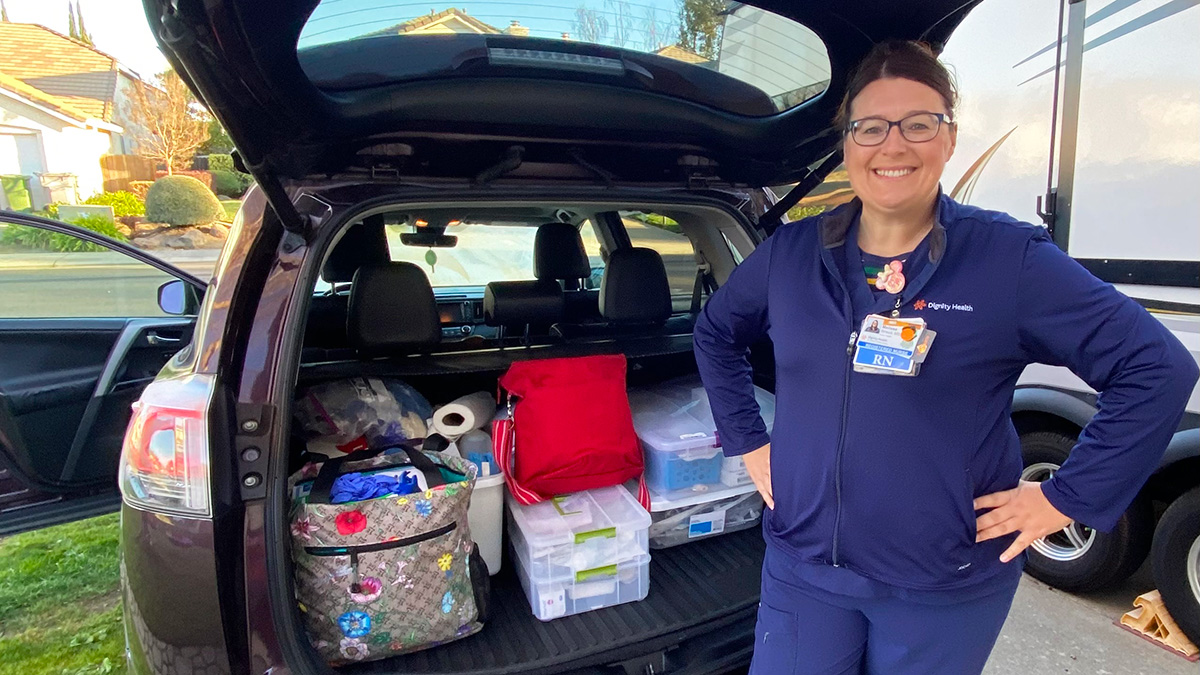
Melissa Stroud, RN, St. Joseph’s Medical Center, Stockton, Calif.
Home health nurses across the country share stories about their demanding but rewarding specialty, including unusual challenges and work during Covid
By Chuleenan Svetvilas
National Nurse Magazine - April | May | June 2022 Issue
Some people might assume that being a home health nurse is an easy job. After all, you get to visit patients in their homes, see to their needs, and go home. Simple, right? Well, think again. The work doesn’t typically end when you see your last patient. You also have plenty of charting and other responsibilities, such as dropping off labs, following up with doctors, ordering supplies, and more. Home health is a complex area of nursing that requires very strong assessment and organizational skills, case management, and a willingness to learn on the job. It’s not for the faint of heart, but it is an incredibly rewarding and fulfilling job. Home health RNs provide continuity of care and get to see their patients heal, learn how to manage their disease successfully, and take responsibility for their health.
These unflappable nurses care for patients who are homebound and whose acuity levels vary greatly. During their visits, the RNs could be educating a patient about their diabetes, changing the dressing on a wound VAC, handling PICC lines for antibiotics, administering infusions to a cancer patient, the list goes on.
When home health RNs walk through the door of a patient’s residence, they never know what to expect. The dwelling could be a spotless apartment, a cockroach-infested mobile home, a multimillion-dollar mansion on the beach, or a frigid house being heated solely by an open oven in the dead of winter. The patient could be recovering well and ready for discharge or in the throes of an unexpected crisis requiring CPR or an urgent call to 911.
“You’re going into an unknown every time,” observed Mary Beth Gagne, who has worked for 30 years in pediatric home health at Maine Healthcare at Home in Portland, Maine. “You have to work well autonomously and not be afraid of going into all kinds of different homes. People can have guns. People can be on drugs. It’s not like working in a hospital where you go into a room.”
If a home health nurse does feel unsafe, she can leave. “If we feel threatened during a visit due to a patient being inappropriate or verbally abusive toward us, we are encouraged to leave that patient’s home immediately,” explained Colleen Lunsford, a home health RN with Dominican Hospital in Santa Cruz, Calif.
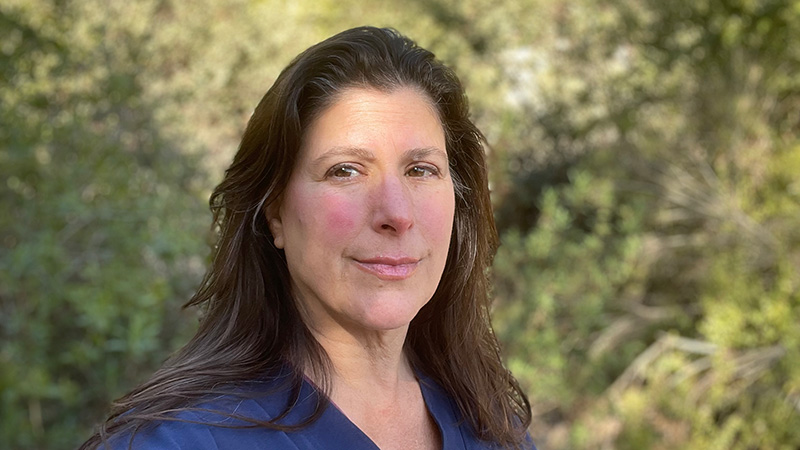
Colleen Lunsford, RN, Dominican Hospital, Santa Cruz, Calif.
Clearly, home health nurses need to be ready for anything and everything. They see it all: Patients with menacing dogs. Family members with Covid. Teens with cell phones ready to post videos of you and their recovering grandparent on TikTok.
Moreover, these fearless RNs are often the only nurse seeing the patient. “You don’t have another nurse right next to you to run something by,” noted Melissa Stroud, the wound ostomy nurse (WON) in the home health department at St. Joseph’s Medical Center in Stockton, Calif. “You can’t call a code blue. If you don’t think something is right, you send them back to the hospital or call 911.”
Kathleen Longwell, RN at Kaiser Permanente San Jose in California, agreed. “It can be stressful because there is no one behind me to check the patient,” said Longwell, who has more than 20 years of experience in home health. “So you can’t miss anything. There is no day shift or night shift nurse to follow up.”
Additionally, home health nurses may be doing something for the very first time, especially when they are first starting out in the field. “If you don’t know what you’re doing, you better figure it out and learn how to do it before you see the patient,” said Gagne who notes that a hospital might have an IV team, but home health nurses do it all.
And even if you do know how to do something, patients will question you, observes Palomar home health RN Glynn Cascolan: Have you done this before? How long have you been a nurse? “Patients will know if you are not in control,” said Cascolan, who has been a home health nurse for 27 years in Escondido, a city 30 miles northeast of San Diego. “Sometimes it’s not the patient but the family member who is in your face. You have to be firm and tell them, ‘This is what the doctor says.’”
Depending on acuity, these intrepid nurses see their patients anywhere from one to three times a week to once a month over a few weeks, several months, or even years for catheter patients. Regardless of the duration of their patients’ care, the RNs get to know their patients intimately and can detect when something is wrong and when they need to call the doctor or an ambulance. “You become a family member in this chapter of their life and then you move on,” said Stroud, who previously worked in post-operative care for open heart surgery. “It’s very rewarding. I get to see the wound, make an assessment, and see it heal. Sometimes you see them get worse and they pass, but it’s still rewarding because you’re there to help the family.”
Carolene Hill, an RN with Hines Veterans Health Administration (VA) in Chicago, is a key part of an interdisciplinary team caring for veterans participating in a voluntary program offering home-based primary care. The other team members include a physician, pharmacist, dietician, social worker, and if needed, a psychologist or psychiatrist (or both). She has been part of the VA home care program for three years but some of her geriatric patients have been participants since its inception a dozen years ago. They are long-term patients whom she sees once a month for their remaining lifespan. “We bring the clinic to their home,” said Hill. “I get to know their families because I am caring for them over a greater length of time.”
Hill’s patients are nearly all elderly veterans who cannot leave their homes to go to VA medical facilities due to mobility issues, dementia, or inability to drive. She teaches them to how to manage their chronic illnesses — hypertension, congestive heart failure, diabetes — with the goal of keeping them out of the hospital. Some patients need more monitoring and more frequent visits due to flare ups in their disease or when their condition declines. Each month she sees anywhere from 25 to 30 patients, including paralyzed veterans and patients with all levels of chronic illnesses. Her patient visits can be as short as 30 minutes or a few hours for higher-acuity patients.
A good portion of home health RNs’ day is spent on the road, depending on the size of their territory, the overall patient census, and staffing. Hill’s patients are within a 50-mile radius. Gagne sees patients in 17 towns in Cumberland County, located in the southern part of Maine. “It’s not uncommon for me to drive 25 miles between patients,” said Gagne whose patients range from babies to children up to age 17 and include prenatal and post-partum patients. “I have driven 86 miles between patients sometimes.”
Their cars are their mobile offices and double as a mini-supply station for some nurses. Patients should be sent home with the supplies and equipment they need, but that doesn’t always happen. Or sometimes supplies are ordered but they haven’t arrived. Cascolan says his car supplies are limited but home health RNs improvise and use what they have until supplies are delivered. Stroud’s supplies are more substantial than other home health nurses due to her scope of practice, which includes wound and ostomy consults.
As the WON, Stroud services all of San Joaquin County, including the cities of Stockton, Tracy, Manteca, Lodi, and rural areas around Lockeford. Her patients need IV therapy, ostomies, or wound care, including vacuum-assisted closures. She also sees cancer patients, not hospice-level, but people who require skilled care with drains. She tries to schedule her patients by region per day, clocking 50 to 60 miles a day as she listens to spiritual music on the radio in between patients. Other nurses in her department are assigned patients within certain zip code pods so they do not drive as far as Stroud. But if they are short-staffed, “zip code pods go out the door,” said Stroud, and everyone takes on extra patients to pick up the slack because they do not have a float pool.
Meanwhile, Cascolan’s patients all are centered around Escondido, where he sees roughly five patients a day, driving about 15 to 20 minutes between each appointment, sometimes less. However, Cascolan noted that his manager does not always take acuity into account in his patient assignments, which can make it tough to get to each appointment without feeling rushed and under pressure.
When patient census is low or home health is short staffed, schedulers sometimes give nurses patient assignments outside of their geographic area. But that also means nurses are spending more time driving than seeing patients. “They don’t see the big picture when they send me all over the place,” explained Longwell. “If they send me to a patient 45 minutes away, I see fewer people and I have less time to chart.”
Apart from driving and seeing patients, home health nurses spend countless hours charting. Some managers push RNs to chart the next day or when they are in the patient’s home. Charting the next day could put their nursing license at risk so home health RNs refuse to do that. After all, Longwell pointed out, what if something happened to the patient at night, after the nurse leaves? Some nurses do not feel comfortable charting in front of their patients because some patients think it is rude or that the nurse is ignoring them. So the RNs often chart in their car or spend hours charting when they get home, which can make for a very long day. Hill’s charting is very extensive because she sees the majority of her VA patients once a month. “I’m charting everything that has occurred since my last visit,” said Hill. “The patient’s appetite, what they threw up, their bowel movements, urine, everything.”
Covid has also had an impact on the acuity of the home health patient population. “The acuity of cases has increased tenfold because hospitals sent them home sicker,” observed Melissa Stroud. “And skilled nursing facilities wouldn’t accept them because of their restrictions on new patients.” As a result, high-acuity patients were discharged from the hospital to be cared for by their families and home health nurses. Some patients were sent home early to reduce their potential exposure to Covid and also to free up beds for other patients. Stroud says these home health patients might spend two weeks at home but then she may have to send them back to the hospital because they needed 24/7 care, their condition declines, or the family is unable to care for them.
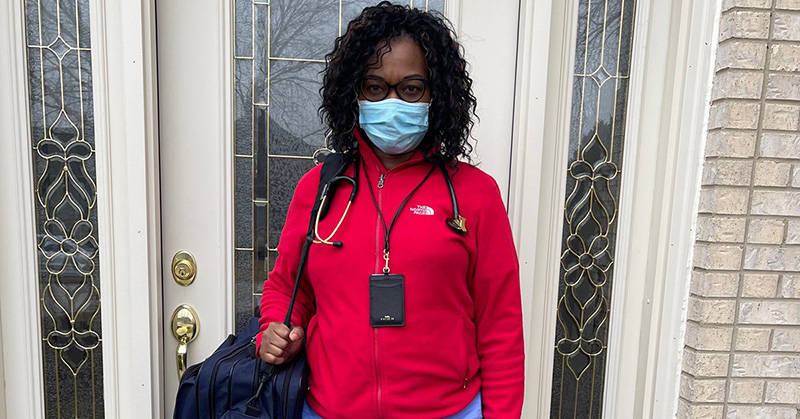
Carolene Hill, RN, Hines Veterans Health Administration, Chicago, Ill.
Fighting for PPE
When Covid-19 hit the United States, home health nurses got another layer of complexity and challenge added to their work. At the start of the pandemic, many home health RNs had to fight for personal protective equipment (PPE) because management mistakenly did not think they needed it. The assumption was that patients were safe at home and did not have Covid, completely disregarding the reality that patients could be exposed to Covid by family members or visiting friends or exposed in the hospital, developing symptoms after discharge. Or as Carolene Hill noted, health care workers at nursing homes, the epicenters of the first Covid surges, often hold part-time home care jobs and inadvertently exposed their homebound elderly patients to Covid.
Early in the pandemic, some home health RNs’ deep concerns about PPE were ignored and many were told that surgical masks were enough because they were not working in a hospital setting. Their hospital colleagues got N95s and other PPE first. “We were the orphans,” Melissa Stroud recalled. “The hospital didn’t want to give us any PPE. They didn’t feel that we needed it. In the hospital, nurses got one mask per day unless it was visibly soiled.”
In Chicago, VA nurse Carolene Hill had a similar experience. “The focus for PPE was on ER and ICU frontline nurses,” remembered Hill who has been a nurse for 32 years, including 20 years in home care. “We were overlooked. The department only offered gloves. My own physician advised me not to work there. He told me, ‘You are on the front line.’”
Hill said the nurses lobbied management, demanding PPE and training on properly donning and doffing the equipment. As a former ICU nurse who had worked during AIDS and Ebola, she knew the importance of PPE during an infectious outbreak. “I also had to keep my veterans safe,” recollected Hill who demanded PPE at the beginning of the pandemic and began wearing it right away. Meanwhile, her department waited until two months after the pandemic began to send nurses to PPE classes. They gave home health RNs only one N95 to use for an entire month and a paper bag to store it in, suggesting that they spray the respirator with bleach to disinfect it. Hill demanded more than one N95 a month and was able to get a new one to use every week.
The VA never officially adopted a PPE policy for home-based primary care. The PPE policy adopted late last year was essentially, “You can use it if you want to.” Now Hines VA nurses can get an N95 whenever they want, but Hill noted, it took two years to get to that point, including letter writing, a march, going to the press, and an outbreak.
Stroud bought her own PPE because she didn’t feel comfortable going to homes with dirty masks. “I was in different homes every day,” remarked Stroud. “I wanted five masks a day. In the beginning, N95s were only for Covid-positive cases. Now we get an N95 or KN95 for any direct patient care. It doesn’t matter if they are positive or negative. I love that.”
Glynn Cascolan said that it wasn’t until he spoke up at a professional practice committee in March 2020, that Palomar home health RNs even got N95s. Hospital RNs got PPE first. “We only had surgical masks, goggles, and paper gowns for aerosolizing procedures,” recalled Cascolan, adding that infection control told home health that that was sufficient. In November 2020, he says his department got powered air-purifying respirators. Fast forward to today and they have access to N95s, but Cascolan says management would like nurses to reuse their N95. He refuses to do that and tosses it after each patient encounter.
Kathleen Longwell, the main preceptor for Kaiser San Jose’s home health RNs, said her employer initially limited the number of N95s nurses could get. And at the beginning of Covid, she noted that home health RNs were the only person seeing the patient. “No one else was going into the patient’s home, not the social workers, doctors, no one else,” said Longwell.
Most of Longwell’s patients are seniors, including some in their 80s and 90s, and many are hard of hearing. When Longwell is wearing PPE, they cannot read her lips when she’s wearing a mask and a face shield plus they have a hard time understanding what she is saying. She recalled her manager telling her she only needed a surgical mask to check on a particular patient. But to be safe, Longwell wore an N95 and it later turned out that the patient’s PCR test was positive. “Thank goodness I had an N95,” exclaimed Longwell who says Kaiser RNs can now get N95s whenever they want.
Fortunately, not all home health nurses had to fight for PPE. Mary Beth Gagne has always had plenty of PPE during the pandemic and never had to reuse anything when caring for her pediatric, prenatal, or post-partum patients. Colleen Lunsford spends part of her time in the field seeing patients and the rest of her time in the office where she answers patient calls and checks orders from RNs, doctors, wound care, and following up on labs, and more. “I always had enough PPE because I don’t work as often in the field,” said Lunsford, who worked as a psychiatric nurse for a decade and then in the ED and trauma unit before landing in home health. Dominican home health nurses only get one N95 to use per day and use alcohol wipes to clean their face shields between visits.
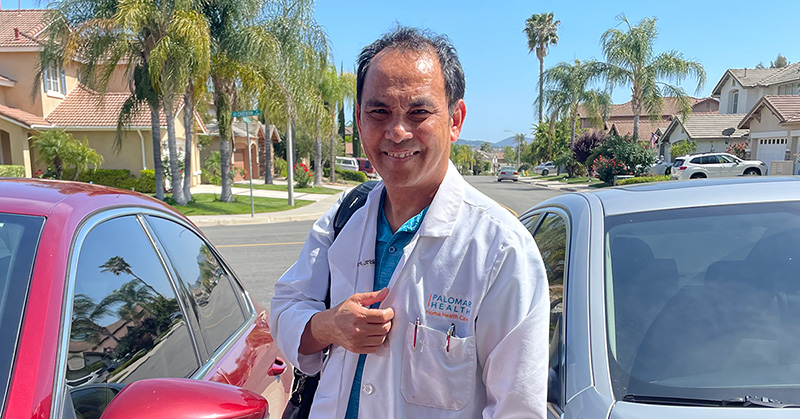
Glynn Cascolan, RN, Palomar Home Health, Escondido, Calif.
Donning and doffing
For home health nurses, PPE comes with its own unique challenges because there is no designated area to don or doff it, plus they have to contend with weather. Chicago-based Carolene Hill said that whenever it is raining or snowing, she will take off her coat, don her PPE in the car, and bring whatever supplies she needs in a big plastic garbage bag. To avoid possible contamination, she leaves her coat in the car, which means she could arrive cold or wet (or both), particularly when she is unable to park nearby. Hill said she and a colleague created a donning and doffing process and presented it to the department: 1. Put everything the RN needs in a plastic bag: yellow gown, N95 in a paper bag, shoe covers, gloves, and another plastic bag; 2. Don in the car. 3. After visit, remove PPE at the door, putting all of it in a plastic bag, open the door with a clean glove, toss it into the bag and throw out the bag. Their proposal was never officially adopted.
In Maine, Mary Beth Gagne also faces harsh winters, with temperatures dropping to 5 degrees or even lower. She dons her PPE in the car, too, leaving her coat behind, and rushes to the patient’s door as quickly as possible to reduce her time outside in the bone-chilling weather. If she is visiting an apartment, she will leave her winter coat outside the door in the hallway and don her PPE before she enters the unit. On her way out she removes the PPE in the hall, puts it in a trash bag for the family to throw away, and slips on her coat.
Another Covid challenge home health nurses face is that their patients — or the people who live with them — may not be masked. The RNs ask them to mask, but not all of them comply. For Carolene Hill, working for the VA meant that a policy about asking patients to mask was extremely slow to be adopted. She said RNs could not ask patients to mask for nearly two years into the pandemic because management told them, “You can’t tell someone what to do in their own home.” It was only in December 2021 that home health RNs were given permission to ask VA patients to wear a mask. And now wearing a mask is a condition of the veterans continued participation in the voluntary home care program.
Obviously, home health RNs need to be vigilant about screening patients and their families before appointments. When Mary Beth Gagne does screenings prior to her visit, some people will tell her not to come because they are sick or have had an exposure. Her patient population includes parents and babies with Covid. When parents can’t take the baby to the doctor’s office, they are assigned a home health RN. Gagne tries to avoid seeing non-Covid and Covid patients on the same day. But if that does happen, she aims to see the cancer patients in the morning and the Covid patients in the afternoon.
Cascolan does what he can to limit his own exposure because he wants to avoid bringing Covid home to his family. He wears an N95 whenever he sees a patient for the first time and asks questions about their vaccination status and whether they have any symptoms. He tells other people to leave the room. Some patients prefer to see him outside. The weather is fairly temperate in north San Diego County so that has been a welcome option.
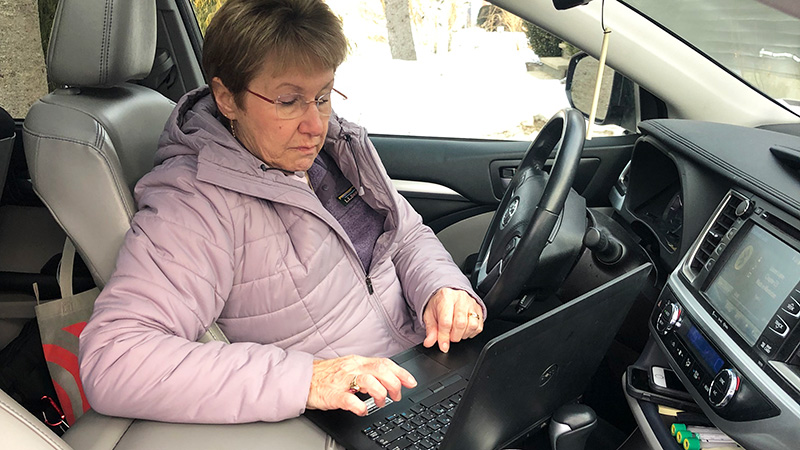
Mary Beth Gagne, RN, Maine Healthcare at Home Portland, Maine
Fulfilling work
“We’re the eyes and ears for the doctors who may not have the time to get all the details,” said Melissa Stroud, who noted that home health has expanded her skill set tremendously. “We see the whole picture. If we have good collaboration, we can keep the patient out of the hospital.”
Being in home health means that you sometimes work closely with a team — physical therapy, occupational therapy, speech therapy, and social worker — to come up with the best plan for the patient. Mary Beth Gagne loves being part of what she describes as a very strong and supportive pediatric team. “We support and learn from each other,” noted Gagne, who worked in the neonatal ICU at two large hospitals and then an obstetrics/gynecologist’s office before she began her home health career. “We’re all working together to create better outcomes for the patient.”
Gagne enjoys the diversity of home care, doing everything from immunizations and chemotherapy to weighing babies and managing central lines as well as seeing prenatal and post-partum patients. “I am a person who doesn’t like chronic care,” admitted Gagne. “I don’t want to do the same thing every day.”
Home health nurses have a lot of autonomy, which is what Kathleen Longwell, a home health RN with Kaiser Permanente San Jose, likes most about her job. “I’m able to work independently,” said Longwell. “I wanted to be a country doctor and I get to do that as a home health nurse.”
“I love what I do,” said Stroud, who has been a home health RN for 11 years. “I can give back to the community I grew up in and provide service to my own county.”
“I like the interactions with patients, being able to help people and make a difference,” said Colleen Lunsford, who worked as a psychiatric nurse for 10 years in a closed unit as well as ER and trauma at other facilities before transferring to home health a decade ago. “I like the intimacy of seeing one patient at a time. I’m not distracted or constantly feeling guilty because I felt like I didn’t do enough.”
“It is very rewarding to see people who weren’t taking good care of themselves, do well and recover,” said Kathleen Longwell. “I run into family members all the time who say, ‘Mom does everything you taught her.’ Home health can be the most rewarding nursing job you will ever have.”
Chuleenan Svetvilas is a communications specialist at National Nurses United.